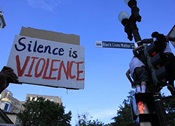
Mission:
To build public health capacity and promote effective policy and practice.
We accomplish this mission by serving as a convenor, catalyst and advocate to build capacity in the public health community.
Vision:
Optimal, equitable health and well-being for all.
Values:
 Community: We are a professional home for a diverse group of people who share a commitment to health and wellness. We believe we have greater potential for impact when we engage partners and community to solve problems, share new ideas and explore different perspectives.
Community: We are a professional home for a diverse group of people who share a commitment to health and wellness. We believe we have greater potential for impact when we engage partners and community to solve problems, share new ideas and explore different perspectives.
 Science- and evidence-based decisionmaking: Good data leads to sound decisions. The best policies and practices are based on research and evidence that demonstrate effectiveness. We embrace and promote research-based policies and practices that advance health equity and improve well-being.
Science- and evidence-based decisionmaking: Good data leads to sound decisions. The best policies and practices are based on research and evidence that demonstrate effectiveness. We embrace and promote research-based policies and practices that advance health equity and improve well-being.
 Health equity and justice: We believe that everyone should be supported by policies, systems and infrastructures that give them the opportunity to attain their best health. This requires valuing all individuals and populations equally. It means addressing inequities in the places where people are born, live and age, and fighting to undo systemic oppression and discrimination at every level of authority and community.
Health equity and justice: We believe that everyone should be supported by policies, systems and infrastructures that give them the opportunity to attain their best health. This requires valuing all individuals and populations equally. It means addressing inequities in the places where people are born, live and age, and fighting to undo systemic oppression and discrimination at every level of authority and community.
 Prevention and wellness: We believe that promoting wellness, preventing disease and injury, mitigating the impact of disasters through preparedness and response, and ensuring an environment where the healthy choice is the easy choice are critical investments that lead to improved well-being and vitality — for individuals and communities.
Prevention and wellness: We believe that promoting wellness, preventing disease and injury, mitigating the impact of disasters through preparedness and response, and ensuring an environment where the healthy choice is the easy choice are critical investments that lead to improved well-being and vitality — for individuals and communities.
 Measurable progress in improving health: Our efforts must contribute to forward movement in improving health outcomes, equity and justice. We do this by championing evidence-based best practices and catalyzing innovative approaches. Sometimes we will leap forward. Other times we take small steps. But always, it is real progress.
Measurable progress in improving health: Our efforts must contribute to forward movement in improving health outcomes, equity and justice. We do this by championing evidence-based best practices and catalyzing innovative approaches. Sometimes we will leap forward. Other times we take small steps. But always, it is real progress.
 Fortitude to persevere: Improving and safeguarding the health of the public is an ongoing endeavor — a long game — that is often as challenging as it is rewarding. We affirm and seek to bolster the collective resilience and courage of our membership and the broader public health community as we continue to strive to ensure all people have the opportunity to live healthy lives, often in the face of strong economic, political and social headwinds.
Fortitude to persevere: Improving and safeguarding the health of the public is an ongoing endeavor — a long game — that is often as challenging as it is rewarding. We affirm and seek to bolster the collective resilience and courage of our membership and the broader public health community as we continue to strive to ensure all people have the opportunity to live healthy lives, often in the face of strong economic, political and social headwinds.
Five-Year Strategic Plan
Overarching Five-Year Goal
Effectively align and mobilize APHA’s resources and influence to build workforce capacity, champion the importance of public health systems and structures to improve the health of the public, advance health equity, improve membership engagement and strengthen association infrastructure.
Strategic Priorities
 Build Workforce Capacity and Effectiveness: Build a vital, versatile, empowered workforce with the skills and capacity to meet current and emerging public health needs.
Build Workforce Capacity and Effectiveness: Build a vital, versatile, empowered workforce with the skills and capacity to meet current and emerging public health needs.
 Champion Public Health: Increase recognition of public health as critical to healthy, vibrant, equitable people and communities among policymakers, the public and other key players across all sectors.
Champion Public Health: Increase recognition of public health as critical to healthy, vibrant, equitable people and communities among policymakers, the public and other key players across all sectors.
 Advance Equitable Public Health Practices and Outcomes: Advance initiatives on behalf of members and the communities they serve to address and reduce the adverse effects of the social and structural determinants/drivers of health, including systemic racism and all forms of intersectional discrimination*, and to drive improvement in equitable and effective public health practices and outcomes.
Advance Equitable Public Health Practices and Outcomes: Advance initiatives on behalf of members and the communities they serve to address and reduce the adverse effects of the social and structural determinants/drivers of health, including systemic racism and all forms of intersectional discrimination*, and to drive improvement in equitable and effective public health practices and outcomes.
 Improve Member Engagement and Satisfaction: Expand membership recruitment and improve retention by increasing the percentage of members who report being very engaged and very satisfied with their APHA membership.
Improve Member Engagement and Satisfaction: Expand membership recruitment and improve retention by increasing the percentage of members who report being very engaged and very satisfied with their APHA membership.
 Execute Operational Excellence: Optimize organizational staffing, infrastructure, governance and funding models to maximize member support and mission impact.
Execute Operational Excellence: Optimize organizational staffing, infrastructure, governance and funding models to maximize member support and mission impact.
*Intersectional discrimination, in this context, refers to the complex constellation of overlapping and interdependent systems of discrimination or disadvantage that occurs as a result of systems of inequality based on gender, race, ethnicity, sexual orientation, gender identity, disability, class, religious/spiritual identity or affiliation, and other forms of discrimination “intersecting” to create unique dynamics and effects. There is a significant body of evidence-based work in the public health and social justice spheres. (Adapted from the work of Kimberly Williams Crenshaw).